Looking for some quick SEO wins to help you rank faster and drive more traffic to your site?
While some SEO tasks may take time to pay off, some can boost your rankings and traffic quite quickly. I’ve seen this work as I’ve studied the thousands of content pieces I’ve created for different brands.
In this article, I’ll show you the top tasks resulting in quick SEO wins in content across many industries.
What are Quick SEO Wins?
Quick SEO wins refer to actionable strategies and tasks that can be executed relatively easily and quickly, resulting in noticeable improvements on search engine results pages (SERPs) and website traffic. These tasks often require minimal resources and can produce results in a short time frame, making them ideal for businesses looking to make immediate progress in their SEO efforts.
Importance of Quick SEO Wins
The significance of quick SEO wins lies in their ability to provide immediate results. These tasks can help:
- Boost rankings: You can improve your visibility in search results by targeting low-hanging fruit.
- Increase organic traffic: Enhanced rankings typically lead to more organic traffic.
- Build momentum: Quick wins can motivate teams and stakeholders by showcasing tangible progress.
- Improve user experience: Many quick wins also enhance site usability, leading to better engagement and conversion rates.
With the competition online getting stiffer by the day, getting quick SEO wins gives you an added advantage over your competitors.
15 Simple Tasks for Quick SEO Wins
1. Use the Right SEO Plugin
Once you’ve laid the foundation for your website, installing the best SEO plugin is the next step to getting quick SEO wins. And for sites built on WordPress, it doesn’t get any better than All In One SEO (AIOSEO).
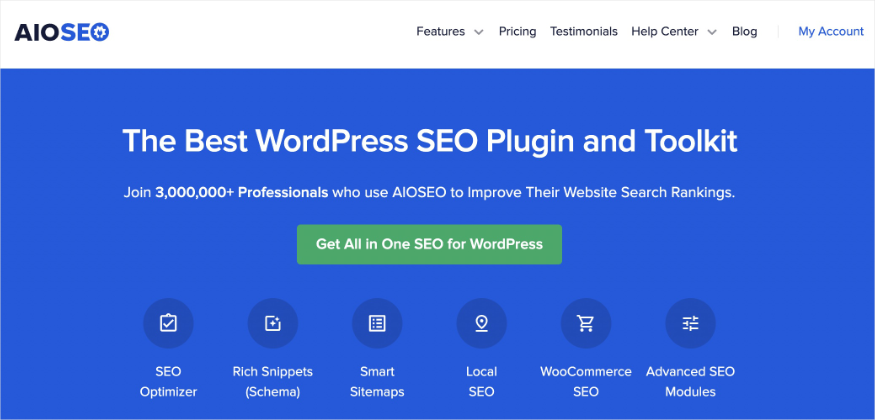
AIOSEO is a powerful yet easy-to-use SEO plugin that boasts of over 3 million active users. Millions of smart website owners and marketers use the plugin to help them boost their search engine rankings and drive qualified traffic to their sites. That’s because the plugin has many powerful features and modules to help you properly configure your SEO settings. Examples include:
- Search Statistics: This powerful Google Search Console integration lets you track your keyword rankings and see important SEO metrics with 1-click, and more.
- Next-gen Schema generator: This no-code schema generator enables users to generate and output any schema markup on their sites.
- AI Title/Description Generator: This AI-powered module automatically generates SEO post titles and meta descriptions that help increase your clickthrough rates and boost your SEO.
- Redirection Manager: Helps you manage redirects and eliminate 404 errors, making it easier for search engines to crawl and index your site.
- Link Assistant: Powerful internal linking tool that automates building links between pages on your site. It also gives you an audit of outbound links.
- SEO Preview: This gives you an overview of your search and social snippets and general SEO so you can improve your optimization.
- IndexNow: For fast indexing on search engines that support the IndexNow protocol (like Bing and Yandex).
- Sitemap generator: Automatically generate different types of sitemaps to notify all search engines of any updates on your site.
- And more.
AIOSEO also has other powerful tools you can use to help your site rank and drive traffic. Plus, the SEO modules in AIOSEO are super easy to use, even without technical or coding knowledge. This makes AIOSEO the best SEO tool for beginner website owners and experts.
For step-by-step instructions on how to install AIOSEO, check out our installation guide.
2. Target Low-competition Keywords
Identifying and targeting low-competition keywords is a powerful strategy for achieving quick SEO wins. Low-competition keywords are terms or phrases with a relatively low search volume but face less competition from other websites.
To find low-competition keywords, you can use tools like LowFruits.
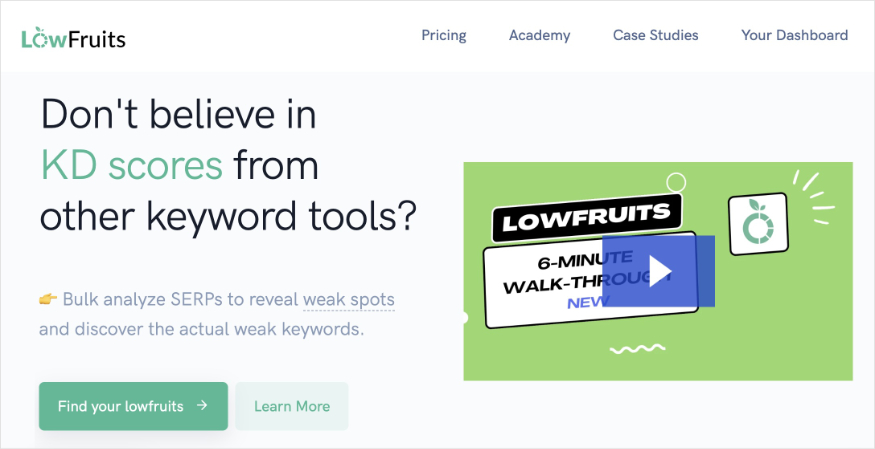

LowFruits is a unique keyword research tool designed to help you unearth low-competition keywords. These are perfect for helping you nail those quick SEO wins. LowFruits identifies weak spots in the SERPs, allowing you to target keywords with a higher chance of ranking. It also provides valuable insights into keyword search volume, difficulty, and related terms.
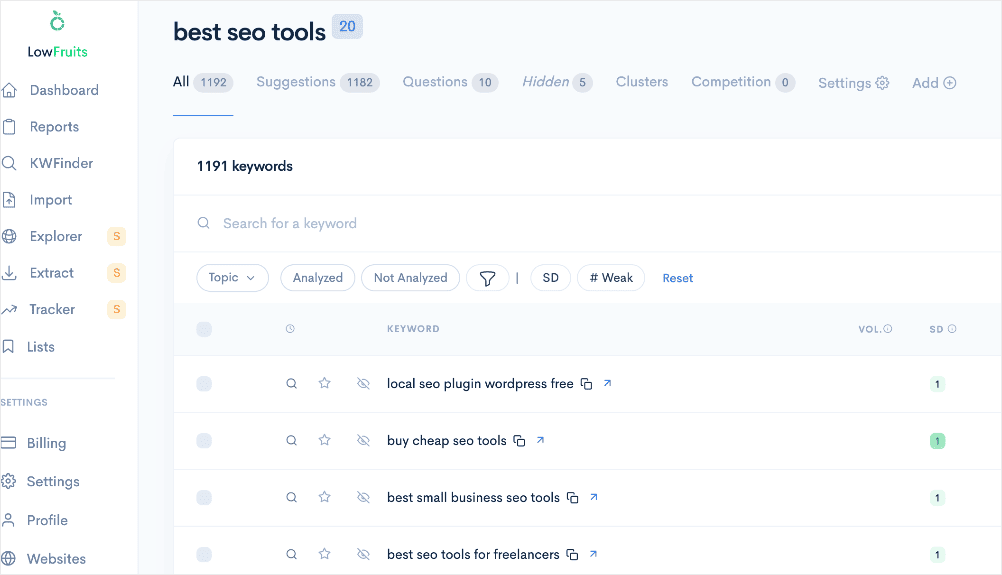

Focusing on keywords with lower competition increases your chances of ranking higher in search results more quickly.
For example, let’s say you run a small bakery and want to rank for the keyword “best cupcakes in town.” However, this keyword is highly competitive, with large bakeries and popular food blogs vying for the top spots. Instead, you could target a low-competition keyword like “gluten-free cupcake recipes” or “mini cupcake ideas.”
By creating content targeting these low-competition keywords, you can establish your website as a relevant and authoritative source in your niche. Over time, as your website gains more authority and backlinks, you can gradually expand your keyword targeting to include more competitive terms.
Remember, low-competition keywords may have lower search volumes, but they can still drive valuable traffic to your website. By focusing on these keywords, you can achieve quick wins and build a solid foundation for your long-term SEO strategy.
An excellent example of using this strategy to get quick SEO wins is Sachin and Babi, a women’s fashion brand. They targeted low-competition keywords for their new collections and gained an impressive 737% YoY boost in organic search traffic. For more details, check out the Sachin and Babi case study.
3. Implement Schema Markup
Schema markup, also known as structured data, refers to code snippets that you can add to your website to provide search engines with additional information about your content. It helps search engines better understand and display your website’s information in search results.
While schema markup may involve code, AIOSEO has a no-code schema generator that makes it easy for anyone to implement schema markup.
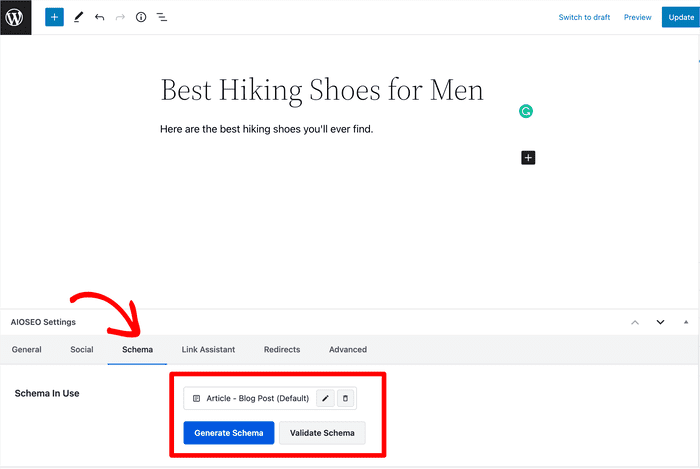

There are various types of schema markup that you can implement to enhance your search listings.
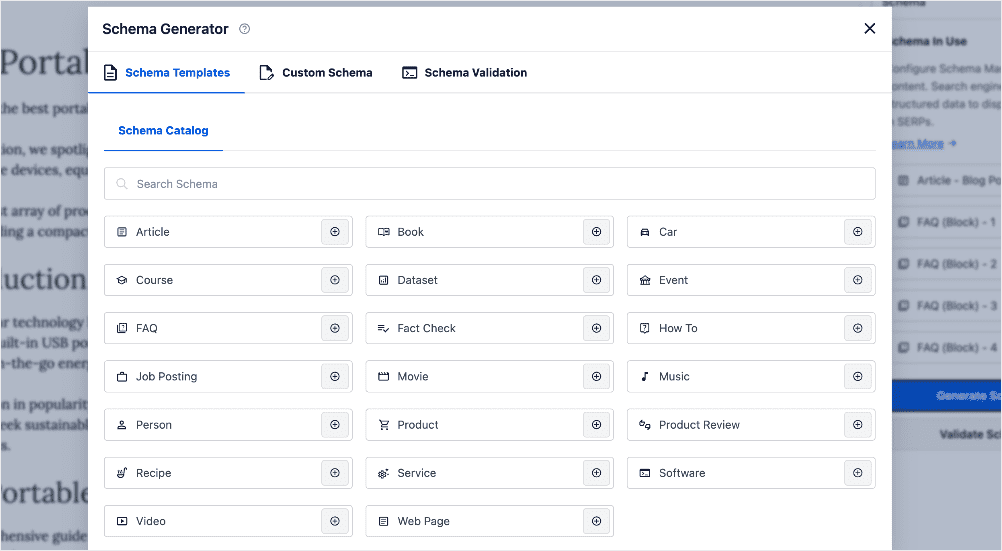

Examples include:
- Article schema: Used for blog posts and news articles
- Product schema: Used for e-commerce product pages
- Product Review schema: Used for displaying customer reviews
- FAQ schema: Used for frequently asked questions
- Fact Check schema: Used to indicate whether a claim is true or false, providing context and credibility to information
- Job Posting schema: Used to describe job openings, making them easier to find for potential candidates.
- Dataset schema: Used to describe datasets, making them discoverable and accessible for researchers and data analysts.
- Service schema: Used to provide information about services offered by businesses
- Course schema: Used to describe educational courses, making them easier for students and learners to find.
- Recipe schema: Used to provide detailed information about recipes, including ingredients, instructions, and nutritional information.
- Music schema: Used to describe musical works, artists, and albums, making them easier for music enthusiasts to find.
- And more.
By implementing schema markup, you can improve the appearance of your search listings, making them more visually appealing and informative to users. This can lead to increased click-through rates (CTRs) and better engagement with your website.
For example, let’s say you have a blog post about the best hiking trails in your local area. Adding article schema to your post can provide search engines with additional information, such as the author’s name, publication date, and featured image. This can result in a more eye-catching and informative search result, leading to more clicks and traffic to your website.
Need a real-life example?
Using this strategy, CJ Eats, an Asian-American food blog, grew its organic traffic by 6,351% year-on-year (YoY).
Implementing schema markup helped them become more visible to users on search engines, increasing clickthrough rate and traffic.
The blog started in 2021, and in just 1 year, organic traffic skyrocketed from 19.8K monthly visits to an incredible 1.3 MILLION! This was clearly a quick SEO win for them. Do you want to try it out?
Check out the full CJ Eats case study.
4. Demonstrate Google E.E.A.T
Google’s E-E-A-T (Expertise, Authoritativeness, and Trustworthiness) is a set of guidelines that search engines use to evaluate the quality and reliability of a website’s content. By demonstrating E-E-A-T on your website, you can improve your chances of ranking higher in search results and gaining the trust of your audience.
To demonstrate E-E-A-T, you can take several steps:
- Showcase your expertise: Highlight your qualifications, experience, and knowledge in your niche. This can be done through your “About” page, author bios, or by featuring relevant credentials and awards.
- Establish authoritativeness: Demonstrate your authority by creating high-quality, well-researched content that provides value to your audience. Regularly publish new content and update existing posts to maintain relevance.
- Build trustworthiness: Earn the trust of your audience by providing accurate, reliable information and being transparent about your business practices. Display customer testimonials, case studies, and social proof to build credibility.
For example, let’s say you run a website that provides financial advice. To demonstrate E-E-A-T, you could include your educational background and professional certifications in your author bio. This can easily be done using AIOSEO’s Author SEO module.
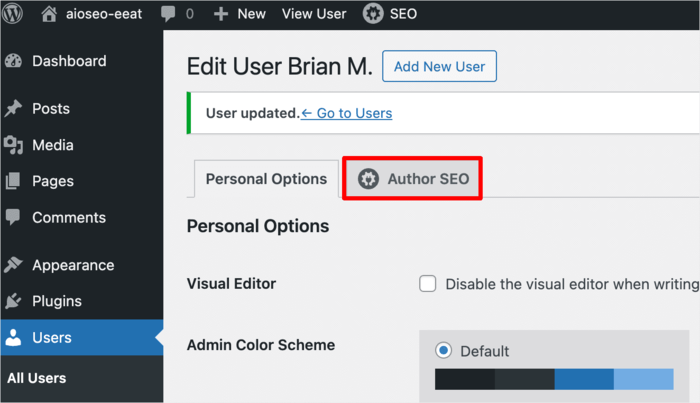

This powerful tool makes it easy to create SEO-friendly author bios that help you demonstrate E-E-A-T. And because the bios output JSON schema markup, it’s super easy for search engines to know that you’re an expert and authority in your field. It also makes it easy to highlight your experience, thereby building trust with search engines and users.
For detailed information, check out our author SEO guide.
Besides leveraging your author bio, you can also demonstrate E-E-A-T by showcasing your experience through case studies and client success stories.
By consistently demonstrating E-E-A-T across your website, you can improve your search engine rankings and establish yourself as a trusted authority in your niche. This quick win can increase traffic, engagement, and conversions over time.
Safe in the Seat is a brand that leverages Google E-E-A-T well to drive organic traffic. In fact, embodying E-E-A-T contributed to their 367% YoY traffic increase. Check out the full Safe in the Seat case study here.
5. Keyword Density Checks
Maintaining the right keyword density is crucial for on-page SEO optimization. Keyword density refers to the percentage of times a specific keyword or phrase appears on a web page compared to the total number of words on that page. While it’s important to include your target keywords throughout your content, it’s equally important to avoid keyword stuffing, which can negatively impact your search engine rankings and user experience.
The optimal keyword density is generally considered to be around 5%. This means that if your page has 1,000 words, your target keyword should appear approximately 10-20 times. However, it’s important to note that this is just a general guideline, and the ideal keyword density may vary depending on the length of your content and the competitiveness of your niche.
In the example below, AIOSEO was used to check keyword density on 2 pages. The first page returned a low-density score and a recommendation to add more instances of the keyword for better optimization.
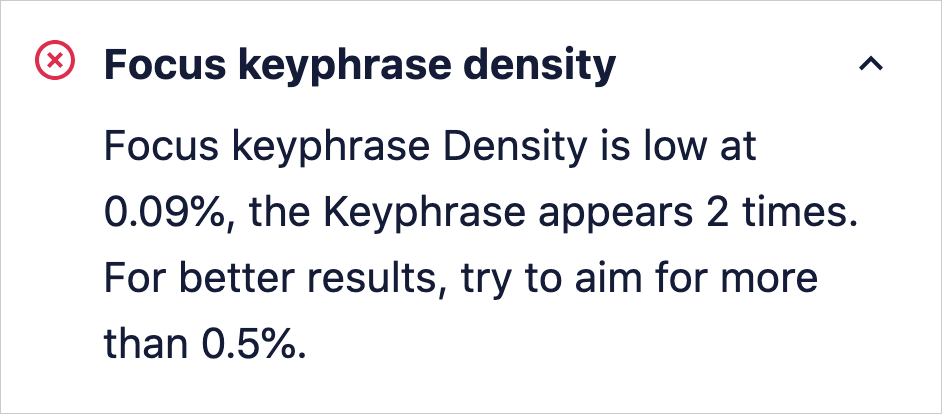

This second example shows the page passed the keyword density check, which aims for a frequency of 0.5% or higher.


For example, let’s say you’re writing a blog post about “best hiking trails in [your city].” Your target keyword density should be around 1-2%, which means that the phrase “best hiking trails in [your city]” should appear approximately 10-20 times throughout your 1,000-word post. The Keyword Density Checker can help you identify any instances of over-optimization and provide suggestions on how to distribute your keywords more evenly throughout the content.
By using a keyword density checker, you can strike the right balance between including your target keywords and providing valuable, readable content for your audience. This quick win can help improve your on-page SEO and increase your chances of ranking higher in search results.
6. Optimize Your Content Using AIOSEO’s TruSEO Analysis
AIOSEO’s TruSEO Analysis is a powerful tool that helps you evaluate and optimize your on-page SEO elements. This feature provides real-time feedback on various aspects of your content, including:
- Keyword usage
- Meta descriptions, SEO titles, and URLs
- Readability
- Image optimization
- Internal and external links
The TruSEO analysis assigns a score to your content and offers specific suggestions for improvement. This instant feedback allows you to quickly identify and address any SEO issues, ensuring that your content is well-optimized for search engines and users.
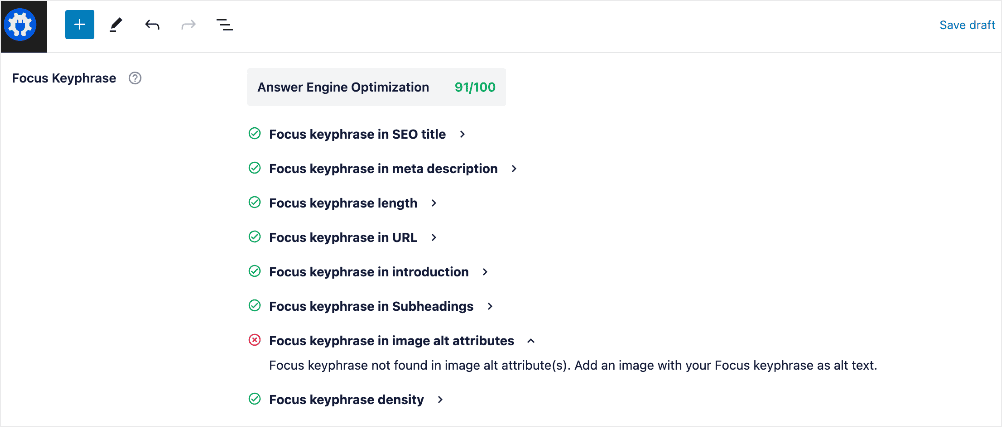

For example, let’s say you’ve written a blog post about “the best vegan recipes for beginners.” After running the TruSEO analysis, you discover that your keyword usage is too low, your meta description is too long, and your readability score is poor.
The tool provides clear instructions on how to optimize these elements, such as:
- Increasing the number of times your target keyword appears in the content
- Shortening your meta description to the recommended length
- Breaking up your paragraphs into shorter, more readable sentences
By following these suggestions, you can quickly improve your on-page SEO and ensure that your content is well-optimized for search engines. This is an excellent way to get quick SEO wins that will help you drive relevant traffic to your site faster.
A great example of the power of content is GameChampions. They increased the number of URLs from 140 to 1.7K in 12 months (May 2023 to May 2024). Because these were high-quality pages meeting on-page SEO requirements, this effort resulted in 10,015% YoY growth.
Check out the GamingChampions case study for more tips.
7. Connect Google Search Console (GSC) for Free
Google Search Console (GSC) is a free tool provided by Google that allows you to monitor and maintain your website’s presence in Google search. By connecting your site to GSC, you can gain valuable insights into your SEO performance and take action to improve your rankings and traffic.
Thankfully, connecting your site has become super easy with AIOSEO. It can help you do so without the hassle of copying and pasting verification codes.
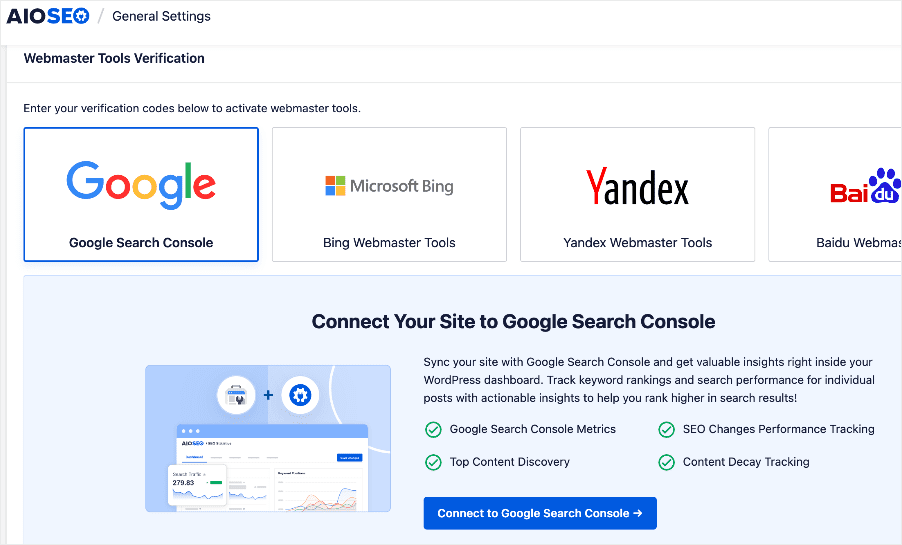

One of the biggest benefits of using AIOSEO to connect your site to GSC is that your sitemaps also sync automatically.
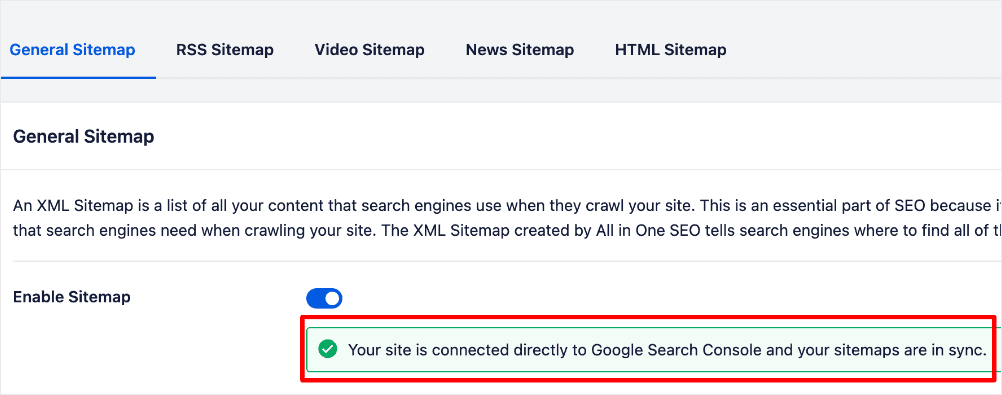

This results in faster indexing and ranking of new content.
Other key benefits of using Google Search Console include:
- Performance monitoring: Track your website’s impressions, clicks, and average position in search results.
- Identifying issues: Detect and fix technical issues, such as crawling errors, indexing problems, and manual actions.
- Receiving notifications: Get alerts about important issues or changes that may affect your website’s performance.
- Identify opportunities: Identify opportunities for improvement, such as targeting new keywords or optimizing your meta descriptions.
By connecting your site to Google Search Console, you can gain valuable insights and take proactive steps to improve your SEO performance. This quick win can help you stay on top of your website’s health and make data-driven decisions to boost your search engine rankings and traffic.
8. Get Instant Indexing with IndexNow
IndexNow is a protocol that allows you to instantly notify search engines whenever you publish new content or update existing content. This protocol helps search engines discover and index your content more quickly, leading to faster inclusion in search results.
One of the main advantages of using IndexNow is that it can significantly reduce the time it takes for search engines to discover and index your content. Instead of relying on search engines to crawl and discover your website’s changes, IndexNow proactively notifies them whenever something changes on your site.
The easiest way to implement IndexNow is to use a WordPress SEO plugin like AIOSEO.
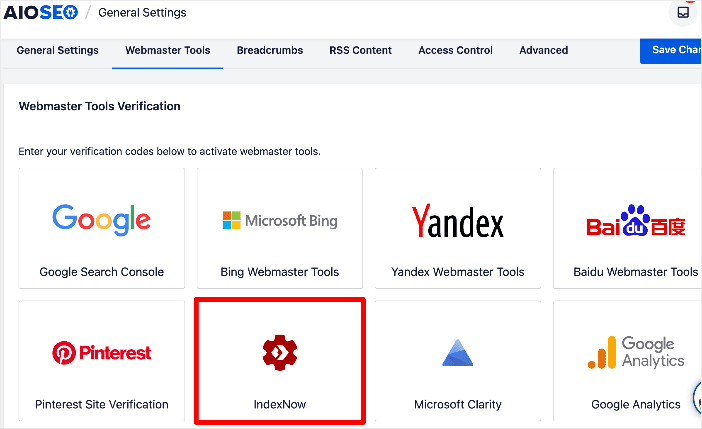

For detailed instructions, check out our tutorial on adding IndexNow to your WordPress site.
Once implemented, IndexNow will automatically send notifications to participating search engines whenever you publish new content or make updates to your website.
Using IndexNow is a quick and easy way to improve your website’s indexing speed and ensure that your content is discovered and ranked by search engines as quickly as possible. By implementing this protocol, you can take advantage of the instant indexing benefits and potentially see a boost in your website’s search engine visibility and traffic.
9. Check Your Post Index Status
Another quick SEO win that doesn’t require much effort is to ensure your content is getting indexed. FYI, indexing refers to the process search engines use to store information about web pages. This information is stored in the search engine’s database, which is called an index. When your content is indexed, it’s easy for search engines to retrieve and present it on SERPs for relevant search queries.
If your website isn’t in Google’s index, your content won’t be displayed for relevant searches.
Thankfully, you can check your post’s index status right inside your WordPress dashboard using AIOSEO’s Post Index Status feature.
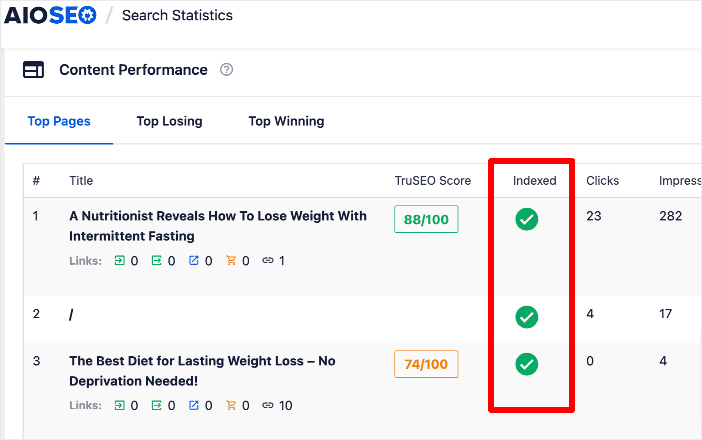

For improved indexing, check out our top tips for indexing your site faster on Google.
10. Use Broken Link Checker to Eliminate Dead Links
Broken links, also known as dead links, are hyperlinks that lead to non-existent pages or return a 404 Not Found error. These links can significantly harm your website’s user experience and SEO performance. When visitors encounter broken links, they may become frustrated and leave your site, leading to higher bounce rates. Additionally, search engines may view your site as less reliable if they frequently encounter dead links, which can negatively impact your rankings.
To maintain a healthy website, it’s crucial to regularly scan for and fix broken links. One of the best tools for this is AIOSEO’s Broken Link Checker.
This powerful tool crawls your site, identifies broken links, and helps you fix them—all with just a click of a button.
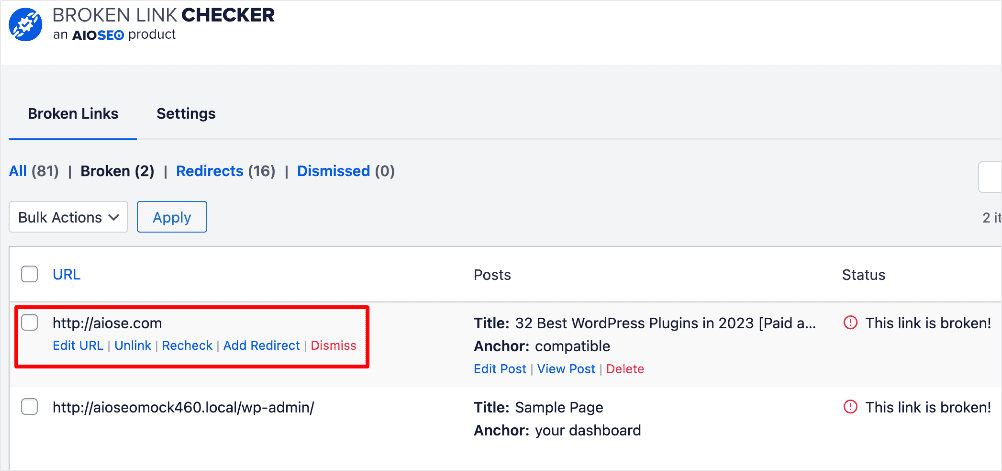

When it finds broken links, the tool gives you action options like:
- Edit URL
- Unlink
- Recheck
- Add Redirect
- Dismiss
The best part is you don’t even need to leave your WordPress dashboard to fix the affected links.
For example, if you run a travel blog and have a post linking to a popular hotel that has since closed down, clicking that link will lead users to a dead page. By using a broken link checker, you can identify this issue, update the link to a different hotel or travel resource, or remove it entirely. This proactive approach not only enhances user experience but also signals to search engines that your site is well-maintained and trustworthy.
Regularly checking for broken links is a quick and effective way to improve your website’s overall performance. By eliminating dead links, you can enhance user satisfaction, reduce bounce rates, and ultimately boost your SEO rankings.
11. Generate Automatic RSS Sitemaps
RSS sitemaps are a powerful tool for helping search engines discover and index your content more efficiently. An RSS (Really Simple Syndication) sitemap is a file that lists all the recent posts or updates on your website, allowing search engines to quickly access and crawl your latest content.
By generating automatic RSS sitemaps, you ensure that search engines are always aware of your newest articles, blog posts, or product updates.
Creating an RSS sitemap is relatively straightforward, especially if you use a content management system (CMS) like WordPress. That’s because WordPress plugins like AIOSEO automate the process of generating RSS sitemaps.
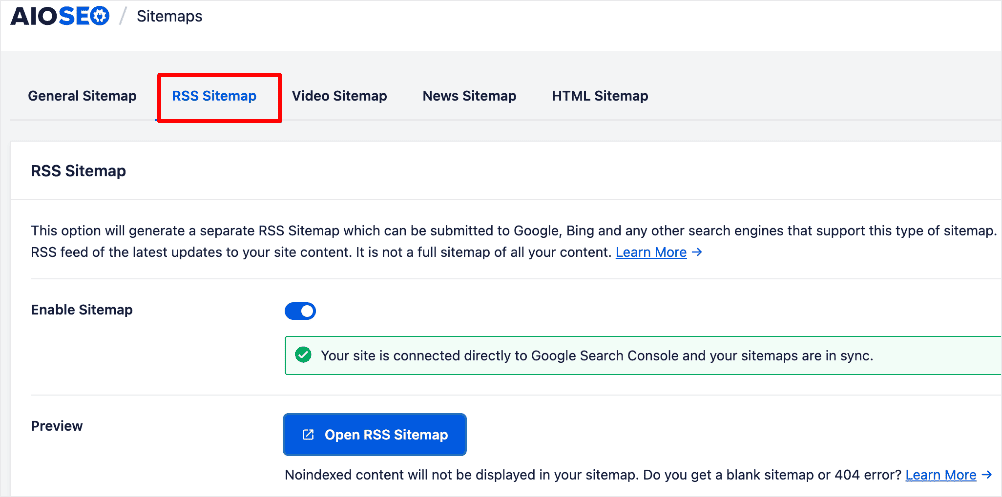

This means you don’t have to manually create or update the sitemap each time you publish new content.
Here are some key benefits of using automatic RSS sitemaps:
- Faster indexing: Search engines can quickly discover your new content, leading to faster indexing and potentially higher rankings.
- Improved visibility: Regularly updated RSS sitemaps can help ensure that your content is consistently visible in search results.
- Enhanced user engagement: By making it easier for search engines to find your content, you increase the likelihood of attracting more visitors to your site.
For example, if you run a news website, having an automatic RSS sitemap means that search engines will be notified immediately every time you publish a new article. This can lead to your articles appearing in search results much faster than if you relied solely on traditional indexing methods.
In summary, generating automatic RSS sitemaps is one of the easiest, quick SEO wins that can significantly enhance your website’s SEO performance. By facilitating faster indexing and improving content visibility, you can attract more traffic and engage users more effectively.
12. Build Topic Clusters
Building topic clusters is an effective strategy for enhancing your website’s topical authority and improving your SEO performance. A topic cluster consists of the following:
- Cornerstone content: This is a central pillar page that covers a broad topic.
- Cluster content: This is a group of related content pieces (or cluster content) that delve deeper into specific subtopics.
Once you’ve built your pillar pages and subtopics, create strategic internal links between them. This process can be automated using AIOSEO’s Link Assistant module.
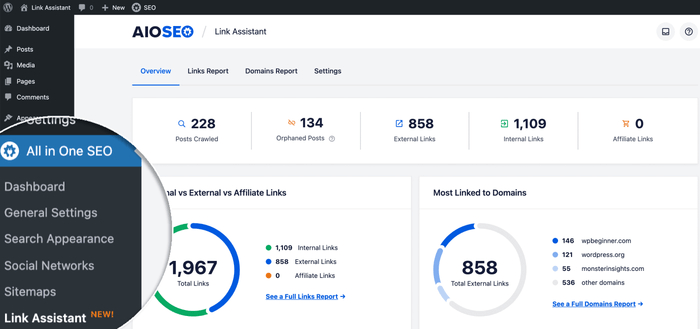

AIOSEO also has a Cornerstone Content feature that makes tagging your pillar pages as cornerstone content easy.
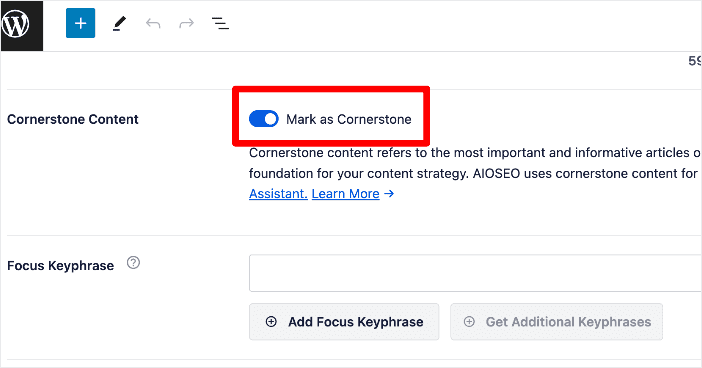

This makes it easier for you to manage your topic cluster strategy.
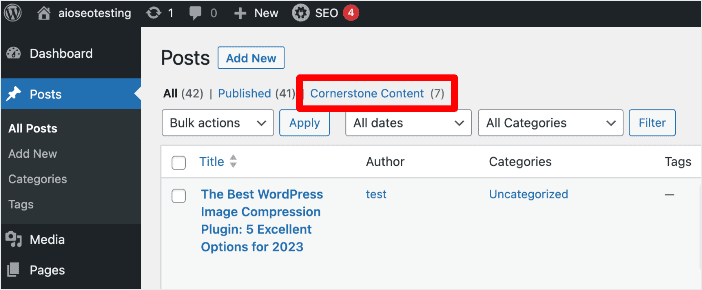

In Link Assistant, cornerstone content is denoted by a building icon:
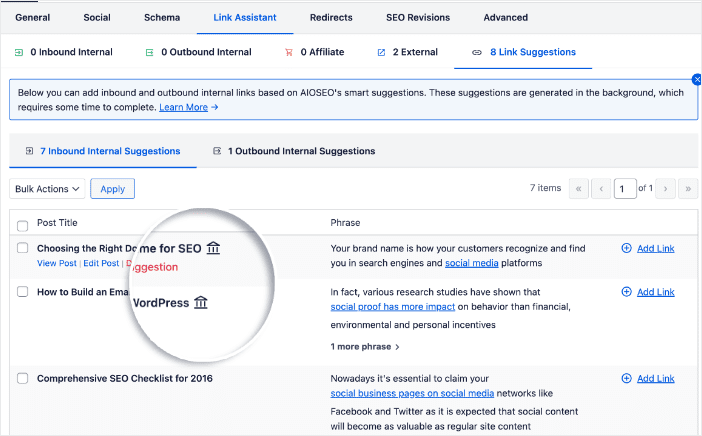

All these make it a breeze to create topic clusters in WordPress.
For example, if you run a fitness blog, your pillar page might cover “Complete Guide to Weight Loss.” This page could link to cluster content such as “Top 10 Weight Loss Exercises,” “Nutrition Tips for Weight Loss,” and “How to Set Realistic Weight Loss Goals.” By organizing your content this way, you improve user experience and establish your site as an authority on weight loss topics.
Integrating topic clusters into your blog content strategy is an easy way to get quick SEO wins. It’s also a fantastic way to create smaller bite-sized content for those who prefer shorter content while meeting the needs of voracious readers.
13. Target the People Also Ask Section
Google’s People Also Ask (PAA) is a special SERP feature that can give you quick SEO wins if leveraged properly. Google’s PAA refers to the SERP feature showing related questions searchers may have about your topic. It usually appears at the top of SERPs, making it a prominent place that increases your search visibility.
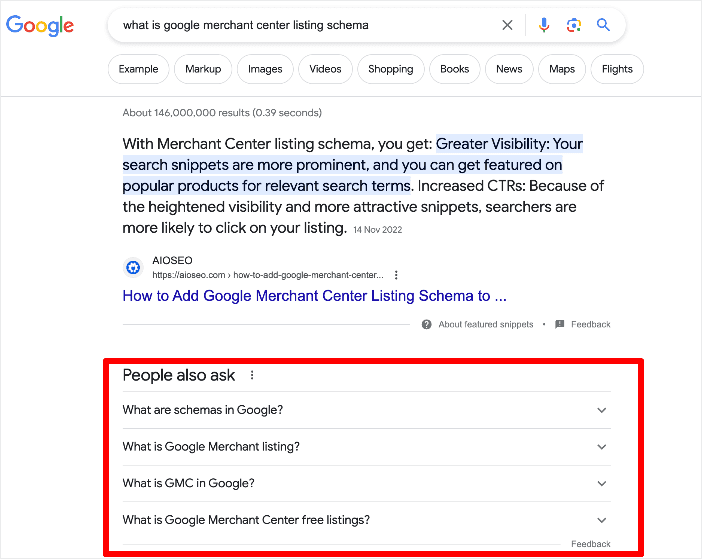

Optimizing for the PAA section is also a great way to enhance your semantic SEO strategy. Answering common questions your target audience asks in relation to your primary keyword helps you create content with semantic depth.
14. Optimize for Featured Snippets
The featured snippet is another SERP feature that can help you drive organic traffic faster. Also called position zero, it’s a special type of search result displayed at the top of SERPs that provides users with a concise answer to their query.
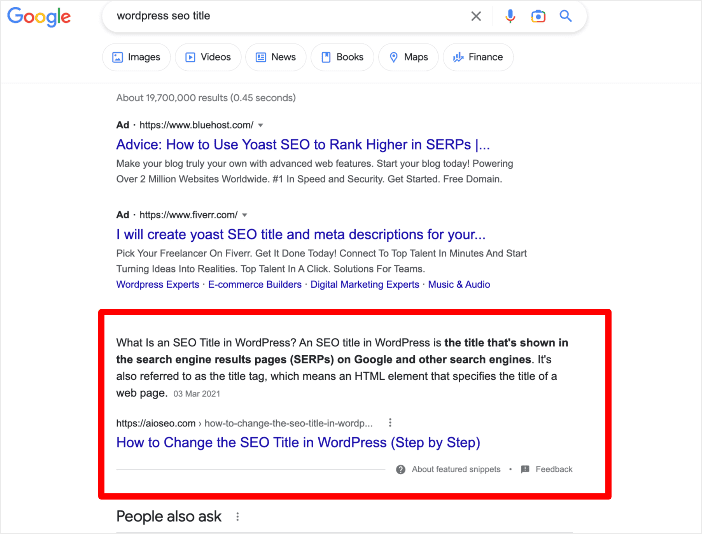

A few ways to land the featured snippet include:
- Implementing schema markup
- Using a table of contents
- Adding FAQs to your content
- Optimizing your content
- Creating the best piece of content on the topic
For tips on optimizing for this valuable spot on SERPs, check out our tutorial on getting the featured snippet.
If you need an example of a brand that used this strategy for quick SEO wins to boost their organic traffic by 595% YoY, check out Frameology’s case study.
15. Use an SEO-friendly Table of Contents
Implementing an SEO-friendly table of contents (ToC) on your web pages or blog posts can significantly enhance navigation and user engagement, which in turn can positively impact your SEO performance.
A well-structured ToC provides readers with a clear overview of the content, allowing them to find the information they are looking for quickly. This not only improves the user experience but also encourages visitors to stay on your page longer, reducing bounce rates.
Adding a table of contents manually in WordPress can be a tedious task. However, AIOSEO makes it super easy. All you have to do is add our Table of Contents block where you want to place your table of contents.
To do so, simply add a block as you normally would and select the AIOSEO – Table of Contents block option:
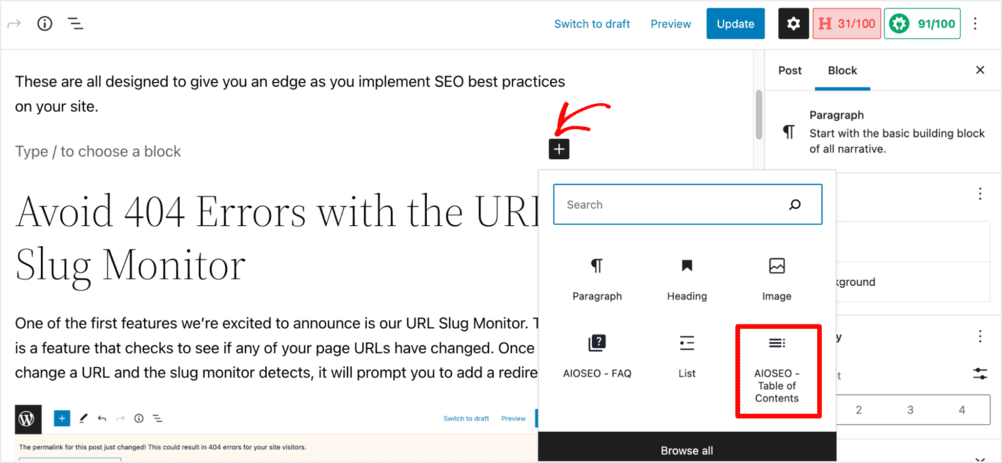

Once you add the Table of Contents block, AIOSEO will automatically create your table of contents from your heading tags. Plus, the table of contents will be hyperlinked so users can jump to the section they want right from the table of contents.
For step-by-step instructions, check out our tutorial on adding a table of contents in WordPress.
Quick SEO Wins: Your FAQs Answered
What are Quick SEO Wins?
Quick SEO wins refer to actionable strategies and tasks that can be executed relatively easily and quickly, resulting in noticeable improvements on search engine results pages (SERPs) and website traffic.
How long does it take to see results from quick SEO wins?
Many quick wins can show results within a few days to weeks, depending on the changes made and the competitiveness of your niche.
Can quick SEO wins replace a comprehensive SEO strategy?
While quick wins are beneficial, they should complement a broader, long-term SEO strategy for sustainable growth.
We hope this post has helped you know how to get quick SEO wins that can help boost your rankings and traffic. You may also want to check out other articles on our blog, like our beginners’ guide to SEO or our ultimate WordPress SEO checklist.
If you found this article helpful, then please subscribe to our YouTube Channel. You’ll find many more helpful tutorials there. You can also follow us on X (Twitter), LinkedIn, or Facebook to stay in the loop.
Disclosure: Our content is reader-supported. This means if you click on some of our links, then we may earn a commission. We only recommend products that we believe will add value to our readers.


